Introduction
The one need only read the food technology releases, whether from academics publishing in the literature to the ‘news’ releases from the food industry to newsletters from the world of investment, to realize that there is an ongoing revolution in the world of meat. Cultured meat forms part of the emerging field of cellular agriculture [1]. Growing muscle tissue in culture from animal stem cells to produce meat theoretically eliminates the need to sacrifice animals, so-called "cultured" or "synthetic" or "in vitro" meat could in theory be constructed with different characteristics and be produced faster and more efficiently than traditional meat [2]. The acceptance of plant-based meats is increasing, along with their commercial successes. The flavors are more nearly approximating those of the conventional meats that they are slowly supplanting. Consumers are attracted to these plant-based meats because of a variety of alterative features, ranging from health of oneself, sustainability of the planet, and simply the novelty of a new fad which is taking root and becoming permanent. In this world of new ‘meat’ is another type of product, cultured meat. Cultured meat is meat grown through cells, from original animal cells. Cultured meat is far less known, and straddles the middle zone between conventional meats to which people are accustomed, and the new plant-based meats which attempt to be meat, but made from plants, and are thus acceptable to vegans and others required to, or wanting to reduce their meat intake.
The
topic of cultured meat is complex, combining different aspects of science,
ecology, food, and emotions. In contrast to plant-based meats which are vegan
and can invoke all the positives from sustainability of the planet to health
benefits, cultured meat emerges from test tubes, from meat, bringing with it a
lot of emotional baggage. Cultured meat has evolved from an idea and concept
into a reality with the August 2013 cultured hamburger tasting in London [3].
As have analyzed on the research paper, the first in vitro meat burger is made in 2013, that was the first step that
have changed the philosophy and the development of in
vitro meat, by using the method of growing the beef by using stem cells
from cow’s shoulder [5].
As Ford on his study in 2010, cited that “in vitro” meat production appears to be a novel and contemporary concept, the idea of cultured meat for human consumption was conceived long back by Frederick Edwin Smith, a writer, who predicted, “It will no longer be necessary to go to the extravagant length of rearing a bullock in order to eat its steak. From one ‘parent’ steak of choice tenderness it will be possible to grow as large and as juicy a steak as can be desired” [4]. Cultured meat (i.e., meat produced in vitro using tissue engineering techniques) is being developed as a potentially healthier and more efficient alternative to conventional meat, and a Life Cycle Assessment (LCA) research method was used for assessing environmental impacts of cultured meat production [7]. Cultured meat or in vitro meat offers a safe and disease-free way forward to meet increasing meat requirement without involving animal sacrifices and at the same time, reducing greenhouse emissions, as compared to conventional meat [8].
The
issues involved in cultured meat emerge from technology and communication.
According to Kadim the technology underlying cultured meat is still in its
early stages. The technical issues are to produce sufficient amounts of the
product, with the in vitro or
synthetic meat constructed to possess the different characteristics of meat
products, the latter being the business issue going hand in hand with the
technology. The reality is that for cultured meat to be a success it must be
incorporated into many products, not just one. The technical issue is to create
a number of different products, for the different kinds of meats that people
purchase and consume. The generation of bio-artificial muscles from satellite
cells has been ongoing for about 15 years, but has never been used for
generation of meat, while it already is a great source of animal
protein and for that in order to serve as a credible alternative to
livestock meat, lab or factory grown meat should be efficiently produced and
should mimic meat in all of its physical sensations, such as visual appearance,
smell, texture and of course, taste [9]. Besides reducing the animal suffering
significantly, it will also ensure sustainable production of designer, chemically
safe and disease free meat with flavor nutritional profile as the conditions in
an in vitro meat production system
are controlled and manipulated [10].
Consumer
acceptance of cultured meat is expected to depend on a wide diversity of
determinants ranging from technology-related perceptions to product-specific
expectations, and including wider contextual factors like media coverage,
public involvement, and trust in science, policy and society [11]. United
States and the European Union commonly discuss cultured meat in terms of
benefits, history, process, time, livestock production problems, and skepticism
[12]. Willingness to purchase plant-based and cultured meat burgers is linked
to age, sex, views of other food technologies, and attitudes towards the
environment and agriculture [13].
Consumer
acceptance of cultured meat is expected to depend on a wide diversity of
determinants ranging from technology-related perceptions to product-specific
expectations, and including wider contextual factors like media coverage,
public involvement, and trust in science, policy and society [11]. Cultured
meat or in vitro meat offers a safe
and disease-free way forward to meet increasing meat requirement without
involving animal sacrifices and at the same time, reducing greenhouse
emissions, as compared to conventional meat [8]. From study ingredients and
production, cultured meat production systems also provide control over meat
composition and quality by modifying flavor, fatty acid composition, fat
content, and especially, the ratio of saturated to unsaturated fatty acids [4].
Today’s
reality is that in vitro cultured
meat production is still in its infancy. That infancy is both technological
(methods), and consumer knowledge and acceptance. The first “In vitro Meat Symposium” in 2008, held
in Norway suggested that it would take 5-10 years to produce in vitro meat products that would be
price-competitive with European beef [12]. That prediction has come true, but
not for cultured meat, but rather for plant-based meat, and a number of
successful entries in the market, such as Impossible Foods, Inc. In contrast, there does not appear to
be a successful or at least widely known success in the world of cultured meat.
Furthermore, even the term ‘cultured meat’ is not clear, whereas plant-based
meat is more descriptive and positive to those who believe that plant-based
diets are good one’s health. This paper explores the reaction of consumers to
different concepts about cultured meat. The objective is to determine whether
it is possible to form a coherent ‘picture’ of the concept of cultured meat, by
presenting respondents with different combinations of phrases pertaining to
cultured meat, and measuring which phrases drive ‘agreement.’ In these types of
studies with well-defined topics, both food and beyond food, respondents have
little problem generating coherent data which provides the picture of the
concept. This study is among the first, if not the first, to work with a
concept that is not well understood by the population because the concept
refers to the production of a familiar but ‘general’ item (meat) by a
technology with which most people are totally unfamiliar (in vitro culturing).
Method
The approach used is known as mind genomics [14]. Simply explained, mind genomics is the experimental analysis of the everyday. Rather than isolating one variable and studying it thoroughly in the manner of today’s science, mind genomics looks at combinations of events or combinations of messages, the more typical situation presenting itself to the person. The objective is to discover how the typical person ‘weighs’ the different aspects of a compound situation to arrive at a decision [14]. Thus, Mind Genomics is really a study of how people interpret and judge the world around them. Mind Genomics is appropriate to understand the nature of the cultured meat ‘concept.’ Mind Genomics works in a ‘Socratic’ fashion, beginning with a topic, moving to four questions which tell a story about the topic, and then on to four answers for each question, the answers being structured as stand-alone phrases. The four questions may not be correct, and the four answers may not all be relevant. Mind Genomics is a fast (hour or two), inexpensive, iterative system which presents combinations (vignette) of thee answers (also known as elements), to a respondent, obtains the rating of each vignette on a simple, anchored scale, and deconstructs the rating into the contribution of the component elements. The objective is to formulate ideas about a topic, test them quickly in combination, so that the respondent cannot intellectualize the answer and thus game the experiment. Table 1 presents the four questions and the four answers to each question. A single question can have different answers, including answers which contradict each other. In the actual creation of the vignettes, each respondent evaluates a unique set of 24 vignettes, comprising 2-4 elements or answers from the four questions, with at most one answer from a question in a vignette. Thus, no vignette could ever simultaneously feature both A1 (Cultured meat is sustainable) and A2 (Cultured meat is less sustainable).
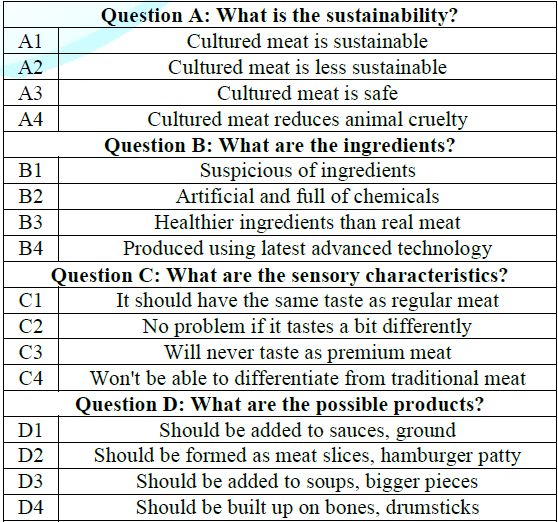
Table 1: The four questions about in-vitro
Virtually
all approaches in conjoint measuring which feature ‘profiles,’ viz., the
aforementioned vignettes, present the same set of vignettes to many
respondents, and by so doing obtain a better estimate of the mean, viz., the
central tendency. The underlying thinking is to average out the random
variability by increasing the base size. Mind Genomics operates in a different
way, creating a unique set of vignettes or profiles for each respondent. The 24
vignettes for each respondent conform to a basic, underlying experimental
design. All that differs is the nature of the combinations, which differ from
respondent to respondent. This is called a permuted design [15].
The
analysis reveals the underlying patterns more clearly because across the set of
respondents there is many more combination tested from the set of possible
combinations (so-called space filling). Metaphorically,
Mind Genomics can be liked to an ‘MRI of the mind.’ Just as the MRI takes many pictures of tissue from different
angles and recombines these pictures into a three-dimensional representation,
so Mind Genomics takes many pictures of a concept, using the different
vignettes and different respondents to generate the different views.
Analysis
The
first step in the analysis reduces the scale to a binary scale, to capture either
Agree/Not Agree, or Disagree/Not Disagree.
The transformations below show the rules. The transformation to a binary
scale makes the explanation of the results easier. In research it may be easy
to use Likert Scale or category scales, but it is difficult to interpret the
results. Managers and others using the data want to be able to look at the data
and form a quick impression of the results to help understand the topic. In
this spirit, the binary transformation works well.
Agree: Rating 7-9
transformed to 100 to show AGREE. Ratings
1-6 transformed to 0, to show NOT AGREE.
Disagree: Ratings 1-3
transformed to 100 to show DISAGREE. Ratings 4-9 transformed to 0 to show NOT
DISAGREE.
The
second step in the analysis used regression to estimate the contribution of
each of the 16 elements to the binary transformed rating, either at the level
of the individual respondent (for mind-set segmentation), or at the level of
the total group (Example: Total, age, gender, mind-set).
The
key to Mind Genomics results emerges from OLS (Ordinary Least-Squares)
regression. The independent variables are the 16 different elements or answers,
coded 0 when absent from a vignette, and coded 1 when present in a vignette. The dependent variable is either the
binary Agree/Not Agree Scale (also called TOP3, from the highest three boxes or
scale points (7-9), a colloquial use adopted from consumer research), or BOT3,
for the Disagree/Not Disagree scale, from the lowest three boxes or scale
points (1-3).
The
equation is expressed as a simple linear function, without an additive
constant. The choice to use an additive constant is left to the researcher. We
will forego the use of the constant in order to compare the TOP3 and BOT3
results, viz., and the coefficients from the OLS regression model. The equation is written as: TOP3 (or BOT3) = k1A1 + k2
A2 …. k16D4.
The
Mind Genomics program also measured the Response Time, defined as the number of
seconds (to the nearest tenth of second) elapsing between the presentation of
the vignette on the respondent’s screen and the rating. The Response Time
became the third dependent variable, which was related to the presence/absence
of the elements in the vignettes. The ultimate aim of the analysis was to
determine how the different elements contribute to agreement to disagreement
and to the response time (or engagement time).
Results-Total panel
Our first analysis loos at the strongest scoring elements from the total panel of 100 respondents, each of whom evaluated a unique set of 24 vignettes. The models for the Total Panel thus are based on 2400 observations or cases, 24 cases from each of 100 respondents. The coefficients in Table 2 show the additive percent of respondents who: Rate the vignette 7-9 when the element is introduced (TOP3)-Agree
Rate
the vignette 1-3 when the element is introduced (BOT3)-Disagree
Table 2 also shows the response time or consideration time, viz., the estimated number of seconds required by the respondent to read the particular element in the vignette.
One
of the first observations to emerge from the study is that opposite elements
emerge as being believed, generating agreement (TOP3). These contradictory
results appear in the column labelled TOP3 (ratings of 7-9, viz., Agree,
converted to 100; ratings of 1-6, viz., Do Not Agree or undecided converted to
0). An example of this mutual contradiction yet agreed to comes from the pair
B2 (Artificial and full of chemicals), and B3 (Healthier ingredients than real
meat). These are opposite, yet strongly agreed to by respondents. The same equal performance of opposites
occurs in elements A1 and A2, dealing with sustainability.
In
the many dozens of other studies run with Mind Genomics, the strong performance
of opposing elements virtually never emerges. Thus, the question is what is happening in this study to allow
agreement to opposing elements, with the opposing elements never appearing with
each other, however. That result simply does not occur in other studies. The most reasonable explanation is that
the concept of ‘cultured meat’ is simply amorphous. The respondents are being
presented with combinations of messages about a product or concept of which
they have little idea. They cannot remember what they rated for other
vignettes, but they do recognize the terms chemical, ingredient, and
sustainability, respectively. And so, perhaps, they simply respond.
When
we look at the second column BOT3 (Do Not Agree), we see fewer results that we
would call mutually contradictory in a dramatic fashion, but there are still
mutual contradictions. The two pairs of mutually contradictory statements are
still close in their disagreement. B2
and B3 (Artificial and full of chemicals; Healthier ingredients that real meat)
show similar disagreements (BOT3=9 for B2, 11 for B3). The bigger difference is
in sustainability, A1 and A2 (Cultured meat is sustainable, BOT3=6, Cultured
meat is less sustainable, BOT3=11). There is a sense here that although the
respondent may not know about cultured meat, there is probably something which
makes it sustainable for the environment.
The final column shows the response time in seconds. Although the respondents cannot tell us how much time they spend reading each element, the underlying experimental design enables us to estimate the number of seconds spent. The response times for all the elements except one (B1 Suspicious of ingredients) are all less than 1.0 seconds. In similar studies with foods and non-foods, the response times, or more correctly the coefficients from the response time models) range from 0.3 to 1.8 or even 2.0 seconds. The response times for these elements are remarkably similar (0.6 to 1.1), and suggest that none of the elements capture the attention of the respondent and engage the respondent. It may well be that the respondents read the information, but do not have a mental model or image of what cultured meat actually is. Thus, the respondents may read the vignettes in a mechanical way, without engagement.
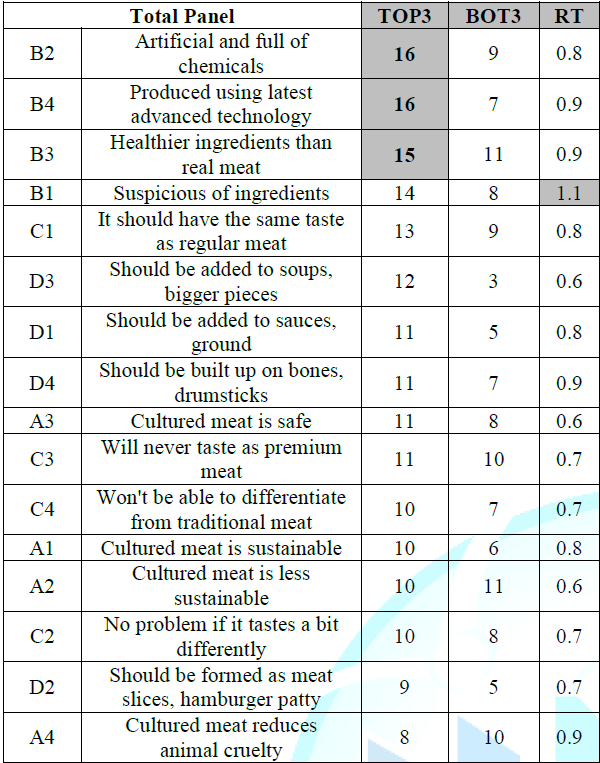
Table 2: Coefficients for the three equations relating
We get a better sense of the lack of a concept about cultured mean by computing the difference between coefficients for A1 and A2 (cultured meat is sustainable vs. cultured meat is not sustainable), and computing the difference for B2 and B3 (Artificial and full of chemicals vs. Healthier ingredients than real meat). Recall that each respondent generated a single model (without an additive coefficient) relating the presence/absence of the element to the TOP3 rating. We create two new variables (Coefficient A1- Coefficient A2; Coefficient B2-Coefficient B3).

Figure 1: Scatterplot from the total panel, showing differences
We have 100 of these pairs, one pair for each respondent. Figure 1 shows a scatterplot of the differences, with the abscissa corresponding to (Coefficient A1-Coefficient A2), and the ordinary corresponding to (Coefficient B2-Coefficient B3). Each circle corresponds to one respondent. Differences around 0 suggest lack of a concept about cultured meat, either for ingredient (abscissa) or sustainability (ordinate). Figure 1 shows many respondents clustering around the center, where both A1 and A2 are similar, and/or B2 and B3 are similar. The location of the individual respondents around 0 in one or both axes suggest that the individual respondents agree with mutually contradictory phrases, and thus do not understand the concept of cultured meat, at least in a way which leads them to form an opinion of what it is, and what it is not
Emergent
Mind-Sets
A
major contribution of Mind Genomics is its ability to reveal new to the world
groups of people who think alike, so-called mind-sets. Mind-sets are defined by
similar patterns of coefficients in the models relating the presence/absence of
elements to the key response, in this study TOP3, agree. The creation of
mind-sets is done using clustering programs with the clustering algorithm
assigning each respondent, in turn, to one of a small number of clusters or
groups, based upon an ‘objective’ statistical criterion [16].
The
criterion for this study is the minimization of the quantity ‘D’ defined as D= (1-Pearson
Correlation). The Pearson correlation, R, measures the strength of a linear
relation between two individuals or objects, based upon a set of measures. A perfect linear relation generates a
Pearson R of 1, so that D, the distance between two people, is 0 (1-1=0). A
perfect inverse relation between two people generates a Pearson R of -1, so the
distance between two people is 2.
One
of the benefits of uncovering mind-sets is its ability to unpack ‘flat data’
from the total panel; coefficients which are fairly low for the total panel,
but which show dramatically different values by mind-set. In most mind genomics
studies, the mind-sets reveal dramatically different groups of respondents. The
interpretation of the mind-sets is simple. For cultured meat, however, the
mind-sets are less clear, indeed quite fuzzy, with each mind-set comprising
messages of two different types. This again is a good indication that the
clarity of the cultured meat concept is modest, at best (Table 3).
Mind-Set 1: Focus on ingredients
and on product form. They agree with the two aspects of chemicals and
ingredients, viz., being healthier, and yet being artificial and suspicious of
that artificiality. We again see evidence that respondents in Mind-Set 1 they
are confused about what cultured meat really is, but they know it involves
chemicals.
Mind-Set 2: Focus on
sustainability and ingredients. They again do not know what cultured meat
really is, agree with both sustainability and non-sustainability, as well as
healthier ingredients versus suspicious of ingredients, respectively. Again, we see a group of respondents
who do not know what cultured meat really is, at least based on their ratings.
Mind-Set 3: Focus on
ethical/social issues, and on product form. They agree with the mutually
contradictory statements of sustainability and non-sustainability.
We
again see the lack of understanding by plotting the differences between A1 and
A2, and between B2 and B3. The scatterplots for the three mind-sets appear in (Figure 2). The two intersecting
rectangles, forming a cross, encompass the region where the respondent
generates approximately the same coefficients for A1 and A2 and or B2 and B3. The cross encompasses many of the
respondents, who generate the same coefficients for mutually contradictory
elements, either for sustainability (A1-A2) or chemicals (B2-B3), respectively.
Mind-Set 3 (Focus on ethical/social issues, and on product form) shows the
highest proportion of those who show similar coefficients, and thus have the
poorest mental conception of what cultured meat really is.
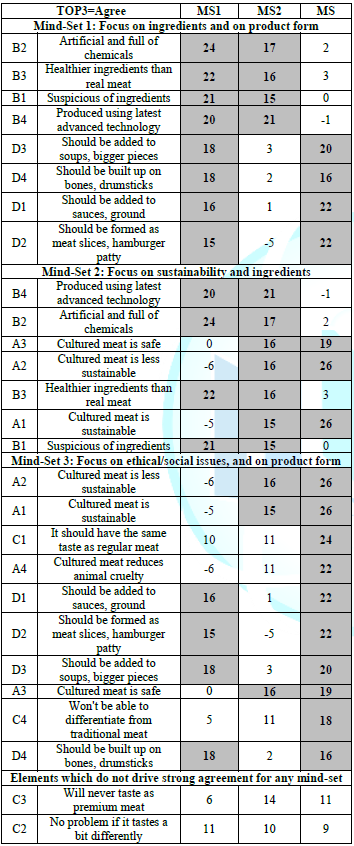
Table 3: Coefficients for the mind-sets relating

Figure 2: Scatterplots from the three mind-sets
When
the metric is the coefficient for disagree with the statement (BOT3), the same
issues arise, but not as clearly (see
Table 4). The models with 1-3 recoded as 100, and 4-9 recoded as 0, again
confirm a lack of understanding of the concept on the part of the three
mind-sets when it comes to chemicals (B2 and B3 achieving similar coefficients,
B2. We will relax the criteria for importance, and thus include coefficients of
+10 or higher for ‘disagree’, rather than the value +15 or higher for ‘agree’
in that was highlighted in Table 3, above.
Mind-Set 1: Focus on ingredients
and on product form-shows a variety of statements with which the respondents
disagree, but there is clearly no pattern.
Mind-Set 2: Focus on sustainability
and ingredients: Disagree equally with both statements about chemicals (B2 and
B3)-also shows a variety of statements which seems to be almost random, with no
clear pattern.
Mind-Set 3: Focus on
ethical/social issues, and on product form: Disagree equally with both
statements about chemicals (B2 and B3)-disagrees with statements about
ingredients, but no clear pattern.
Distribution
of Mind-Sets in the Population
Table
6 shows the distribution of respondents in the three mind-sets by total, state,
gender, age, respectively. At the surface level there is no clear association
between who a person IS and the mind-set of the person (Table 6). When researchers work with different groups of people,
the best practices prescribe that the respondent population be described by who
the person IS, by what the person does, and by what the person believes, at
least in a macro sense. Except in the
unusual of circumstances it is difficult to pigeonhole a person into a mind-set
by the first two, is and does. Simply
knowing a person’s general geo-demographic
characteristics does not predict the mind of the person. Nor, in fact does
behavior predict the mind. We may all do the same thing, albeit for different
reasons. Finally, how a person thinks about general topics (Example- nutrition,
sustainability, cruelty to animals) does not suffice to predict how a person
will respond to granular, more specific information. A person may want to
sustain the earth but shudder at the thought of cultured meat from a test tube.
Discussion and Conclusions
Previous
studies with Mind Genomics going back up to two decades suggest that it is
straightforward to uncover the way people make decisions about many topics,
ranging from food to politics to ethics and the law, medicine, and so forth [14].
The results from mixing
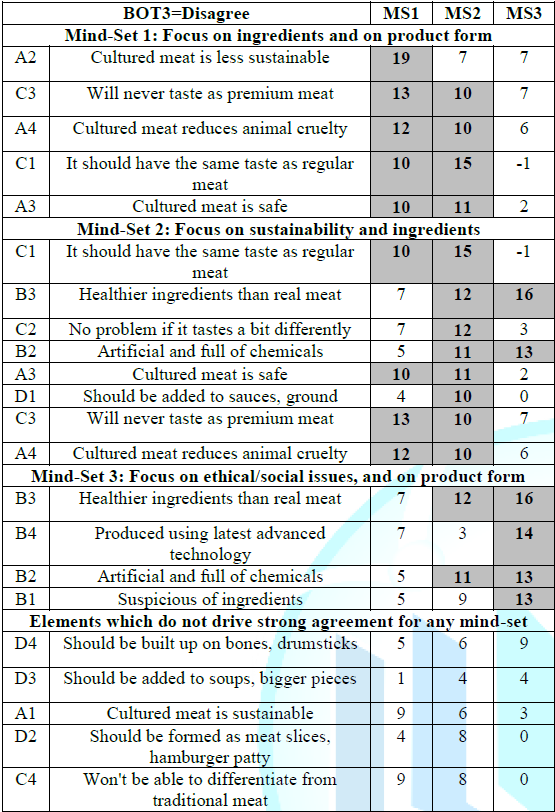
Table 4: Coefficients for the mind-sets relating
together
ideas by experimental design, presenting these to respondents, and
deconstructing the ratings into the part-worth contributions of the different
elements, the different components, are generally consistent and enlightening.
In
the light of the extensive, almost three-decade period of use of mind genomics
in both scientific and business applications, one would assume that the
approach would work when the topic is a new technology, cultured meat. There
is, after all, a parallel world called plant-based meat, instantiated by
companies such as Impossible Foods, Inc., and beyond meat, Inc.
These
plant-based meats have achieved an increasing degree of success over the past
several years, and used by consumers who buy the product frozen to prepare at
home, or who have hamburgers at quick serve restaurants.
The
reason for the failure of mind genomics to map out the concept of cultured meat
may well be traced to the fact that although the scientific notion of in vitro cultivation is known widely in
the scientific community, the term ‘cultured meat’ does not resonate
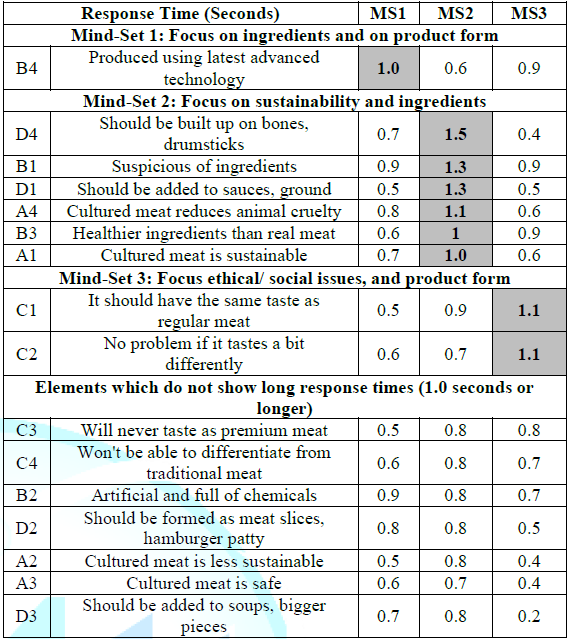
Table 5: Coefficients for the mind-sets relating

Table 6: Distribution of the mind-sets in the population
with
consumers. It may be that they associated it with other food items that have
the word ‘cultured’ in their names, such as ‘cultured’ milk, used for
buttermilk or kefir, milk whose composition is changed by bacterial cultures. The
problem may thus be traceable to the unfortunate use of a scientific term,
cultured, associated with probiotics, rather than some other name. Certainly,
the notion of ‘cultured’ meat is not easy to explain, and nowhere as evocative
as the apparently less-used but more realistic name ‘test-tube meat.’
This
is a first, exploratory study of the topic of cultured meat. It may be
instructive to repeat this study once a year over the next decade to map out
the change, and possible the emerge of the concept of cultured meat as the
technology matures, and as products created by culturing meat cells in vitro enter the market and achieve
commercial success.
References
- Stephens
N, Di Silvio L, Dunsford I, Ellis M, Glencross A, et al. Bringing cultured meat
to market: Technical, socio-political, and regulatory challenges in cellular
agriculture (2018) Trends in Food
Science and Technology 78: 155-166. https://doi.org/10.1016/j.tifs.2018.04.010
- Kadim
IT, Mahgoub O, Baqir S, Faye B and Purchas R. Cultured meat from muscle stem
cells: A review of challenges and prospects (2015) J Integrative Agriculture 14: 222-233. https://doi.org/10.1016/S2095-3119(14)60881-9
- Verbeke
W, Marcu A, Rutsaert P, Gaspar R, Seibt B, et al. “Would you eat cultured
meat?”: Consumers’ reactions and attitude formation in Belgium, Portugal and
the United Kingdom (2015) Meat Science
102: 49-58. https://doi.org/10.1016/j.meatsci.2014.11.013
- Arshad
MS, Javed M, Sohaib M, Saeed F, Imran A, et al. Tissue engineering approaches
to develop cultured meat from cells: A mini review (2017) Cogent Food & Agriculture 3: 1-11. https://doi.org/10.1080/23311932.2017.1320814
- Zaraska M. Lab-grown beef taste test: ‘Almost’
like a burger (2013) Health and
Science T Washington post Published, 5.
- Ford
BJ. Culturing Meat for the Future:
Anti-Death versus Anti-Life (2010)
Death and Anti-Death 7: 55-80.
- Tuomisto
HL and Teixeira De Mattos MJ. Environmental
Impacts of Cultured Meat Production. Environmental Science and Technology 45:
6117-6123. https://doi.org/10.1021/es200130u
- Gaydhane
MK, Mahanta U, Sharma CS, Khandelwal M and Ramakrishna S. Cultured meat: state
of the art and future (2018) Biomanufacturing
Reviews 2018. https://doi.org/10.1007/s40898-018-0005-1
- Post
MJ. Cultured meat from stem cells: Challenges and prospects (2012) Meat Science 92: 297-301. https://doi.org/10.1016/j.meatsci.2012.04.008
- Bhat
ZF and Fayaz H. Prospectus of cultured meat - Advancing meat alternatives
(2011) J Food Sci Technol 48: 125-140.
https://doi.org/10.1007/s13197-010-0198-7
- Verbeke
W, Sans P and Van Loo EJ. Challenges and prospects for consumer acceptance of
cultured meat (2015) Journal of
Integrative Agriculture 14: 285-294. https://doi.org/10.1016/S2095-3119(14)60884-4
- Goodwin
JN and Shoulders CW. The future of meat: A qualitative analysis of cultured
meat media coverage (2013) Meat
Science 95: 445-450. https://doi.org/10.1016/j.meatsci.2013.05.027
- Slade
P. If you build it, will they eat it? Consumer preferences for plant-based and
cultured meat burgers (2018) Appetite
125: 428-437. https://doi.org/10.1016/j.appet.2018.02.030
- Alexander R. In
vitro meat: A vehicle for the ethical rescaling of the factory farming
industry and in vivo testing or an intractable enterprise
(2011) Intersect 4: 42-47.
- Moskowitz HR. ‘Mind Genomics’: The
Experimental, Inductive Science of the Ordinary, and Its Application to Aspects
of Food and Feeding (2012) Physiology
& Behavior 107: 606-613. https://doi.org/10.1016/j.physbeh.2012.04.009
- Gofman A and Moskowitz H. Isomorphic Permuted
Experimental Designs and their Application in Conjoint Analysis (2010) J Sensory Studies 25: 127-145. https://doi.org/10.1111/j.1745-459X.2009.00258.x
- Jain AK and Dubes RC. Algorithms for Clustering Data (1988) Upper Saddle River, NJ: Prentice-Hall, Inc.
Corresponding author
Howard Moskowitz, Mind Genomics Associates, Inc., White Plains, New York, USA, E-mail: mjihrm@gmail.comCitation
Moskowitz H, Gere A, Roberts D, Nagarajan D and Harizi A. Cultured meat: a mind genomics cartography of a technology in its infancy (2020) Edelweiss Food Sci Tech 1: 38-44.Keywords
In vitro, Cultured meat, Ecology and Engineering techniques


 PDF
PDF